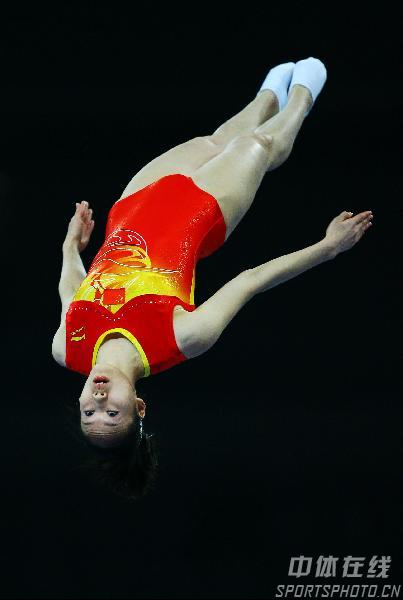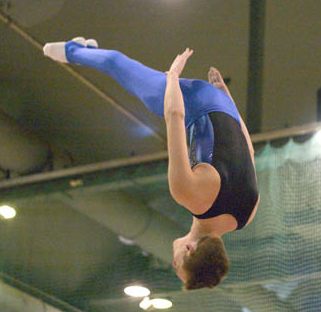OCR Unit 6.1
Gymnastics Based Sport - Trampolining
Trampolining is a competitive olympic sport in which gymnasts perform acrobatics while bouncing on a trampoline.
Moves
In competitions, moves should be performed in one of the three basic shapes -
| Tucked - | with knees clasped to chest by hands |
| Piked - | with hands touching close to feet and both arms and legs straight |
| Straight - | straight posture throughout body |
A fourth basic shape, is known as puck because it is a mix of pike and tuck, and is often used in multiple twisting somersaults.
A straddle is a variant of a pike with arms and legs spread wide and is not used in somersaults, only jumps.
The slightly more complicated moves are the front and back somersaults. In this move you perform a front/back flip in the air and land with your body vertical with your feet landing on the trampoline bed.
The most advanced moves are -
Barani
This move is like a somersault. The only difference is you twist your body as you perform the flip.

Double somersault
This move can be performed backwards or forwards. You perform a flip in the air two times and again, land with your body vertical.
One and three
In this move you perform a one and three quarter front somersault landing on your back.
Two and three
This move is almost the same as the one and three move, however you perform a two and three quarter front somersault instead.
Randy
In this move you perform a two and a half front somersault while your body is twisting.
Back In Full
In this move you perform a double back somersault with a full twist of the body only on the second somersault.
Full, Full
In this move you perform a double back somersault with a full twist of the body on both somersaults, rather than only on the second.
In this move you perform a double back somersault with a full twist of the body on both somersaults, rather than only on the second.
Competitions
Individual trampoline - http://www.youtube.com/watch?v=_XrE-_D1tCw
Synchronized trampoline - http://www.youtube.com/watch?v=Wd1FKepb0Xk
Double mini trampoline - http://www.youtube.com/watch?v=h0d9pA2Q4Xg&feature=related
The currently accepted basic format for individual trampoline competitions usually consists of two or three routines.
In synchronized trampolining, two athletes perform exactly the same routine of ten skills at the same time on two trampolines situated next to eachother.
A double - mini trampoline has a sloped end and a flat bed. The gymnasts run up and jump on to the sloping end and then jump on to the flat part before landing on to a mat. Skills are performed during the jumps or as they land.
Trampolining in the Olympics
The Olympic games in 2000 was the first ever time in which trampolining was performed at any olympics. Russian gymnast Irina Karavaeva won the first gold medal in this event. Oxana Tsyhuleva took silver and Karen Cockburn took bronze.
Trampolining in the Olympics
The Olympic games in 2000 was the first ever time in which trampolining was performed at any olympics. Russian gymnast Irina Karavaeva won the first gold medal in this event. Oxana Tsyhuleva took silver and Karen Cockburn took bronze.
 |
| Irana Karavaeva |
Each move is worth 1 mark from each judge. Each form judge can deduct between 0 and 0.5 marks for each move. A zero deduction represents a perfect move (e.g. well executed), and a 0.5 deduction is not wanted at all. Extra deductions can be made by the superior judge for errors such as touching the frame pads, communicating with the coach, repeating a move etc.
Judges are looking for these main things -
Consistency of height: keping up the same height throughout form and control.
Form: is concerned with the neatness of the move which is the performed shape held correctly, and that there are clear phases to the move etc.
Control is reflected in how well centred the moves are such as whether the trampolinist lands on the cross every time.
Governing Body
The Federation International Gymnastique which is also known as FIG, represents gymnastics in all forms. The FIG strengthens sportsmanship between gymnasts around the world and is responsible for promotion in different countries. The FIG also gives instructions to those who are dishonest or who are cheating, for example the judges.
Finally the FIG is responsible for making every sport big in the spirit of the Olympics.
Competitions
Trampolining and Tumbling World Championships
Summer Olympics
Rules
- Judges are looking for good form and execution, difficulty, variety, and the correct landing
- In the qualifying round gymnasts perform an optional and compulsory routine
- The compulsory routine consists of ten sets of skills
- Every routine should finish in an upright position
- There is no time limit to a routine
- This sport is for both men and women
- Artistry in a routine earns bonus marks
Dimensions of the Trampoline
Top Players
Jason Burnett
Irina Karavaeva

Huang Shanshan
















No comments:
Post a Comment